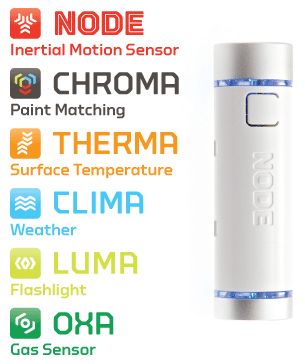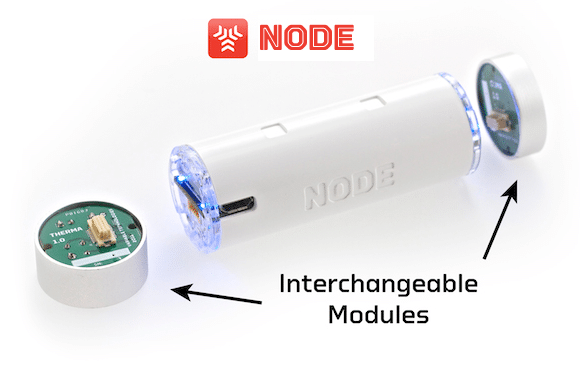
For those of you under 20, or for those of you who have been living inside an anti-Star-Trek protective cloth and plastic diaper, in Star Trek the officers and technicians had these things called “tricorders.” They looked like this:
This little handheld piece of imaginary engineering could do everything — it could detect life forms, it could do video and audio, images, it could record stuff, it could take medical analysis and readings… it was like some kind of crazy high-tech iPhone for the USS Enterprise. You can actually get the toy Tricorder on Amazon
for ten bucks. Hell, I always wanted one of these when I was of the age where you could still run around the neighborhood with toy guns and not get shot by the cops. Remember those days?
Fast forward to the beginning of January of this year, 2013 — there is a company called Variable Technologies in Chattanooga, TN that makes this little device called the Node. It’s a handheld sensor that connects with several apps for iPhone et al via Bluetooth 4 to do exactly what the original tricorder was supposed to do — take readings, scan things, record things, and analyze. Node is made to have these little interchangeable sensors that attach to the home unit, which is handheld:
Node has all kinds of awesome modules:
- NODE, an IMU (Inertial Measurement Unit) which is built-in to the device
- CHROMA, a colorimeter
- THERMA, a thermometer for surface temperature
- CLIMA, for weather conditions
- LUMA, a flashlight attachment
- OXA, a gas sensor module
 All in all, this is a pretty cool little gadget! I really hope this isn’t small-minded out of existence by people who think that anything useful that is also handheld must only come from the iPhone itself, including its sensors. From the Node site, specifications on the Node handheld unit itself:
All in all, this is a pretty cool little gadget! I really hope this isn’t small-minded out of existence by people who think that anything useful that is also handheld must only come from the iPhone itself, including its sensors. From the Node site, specifications on the Node handheld unit itself:
Highlights:
9 degrees-of-freedom motion engine
2 interchangeable module ports
Open API with all modules
long-range Bluetooth 4.0 SmartDirectly useful for:
Motion mapping for animation or physical therapy
Motion-based cues like telling when the washer stops or the door opens
Impact testing
Use as a gesture-based remote control
Multiple, simultaneous data streams…
…and some specifications — the IMU inside has 9 degrees of tracking!
Dimensions:
Diameter: 1 inch (25.4mm)
Length: 3.27 inch (83 mm)
Weight: 45gPower:
Battery Life: 12 hr continuous use, 30+ days standby Rechargeable Li-Polymor Battery
Micro-USB ChargingCommunications:
Bluetooth 4.0 SmartUSB data communications256-bit encryption engine
Sensor Capabilities
3-axis accelerometer: up to +/-8g range, 0.061mg resolution3-axis magnetometer: up to +/-8 gauss range, 0.04 milli-gauss resolution
3-axis gyroscope: up to +/-2000 degrees-per-sec, 0.061 degrees-per-sec resolution
9-degrees-of-freedom orientation engine
Awesome. Handheld sensing, here we come! And stylish, too! It certainly looks as though we won’t be disappointed by the Node, especially the price — it’s only $150 for the base Node with IMU and each sensor kit is only $75 bucks. All of Node’s apps (Node is definitely app-driven) are all available in the App Store!
Thanks to MedGadget, an awesome blog, for the initial story!






